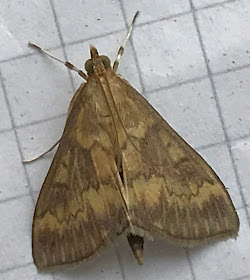Yes, that's not an oxymoron, there is such a thing! The one moth of interest in last night's garden catch was this
Agriphila latistria. The books say it is confined to dry, sandy habitats particularly around the coast but this is the second individual I've had in the garden here where we are a typically damp area on heavy clay. The previous example was caught almost two years ago to the day (28th August 2016). That was a first for VC24 Bucks and I'm not aware of any subsequent records. So keep checking those tristellas - you may find this amongst them as well as
Agriphila selasella which is having a good year too.
Agriphila latistria is noticeably "different", having a whitish head and that broad pure white band stretching right to the fringe at the termen.
 |
| Agriphila latistria, Westcott 27th August 2018 |
 |
| Agriphila latistria, Westcott 27th August 2018 |
The remainder of last night's catch comprised 242 moths of 48 species. To show that there are still plenty of moths out there, including many second-generation individuals now even if we are getting little that is actually new, here is the full list:
Coleophora sp (1),
Bryotropha affinis (1),
Bryotropha terrella (1),
Aproaerema anthyllidella (1),
Archips podana (1),
Epiphyas postvittana (1),
Celypha lacunana (3),
Cydia pomonella (3),
Grapholita funebrana (1),
Agriphila tristella (12),
Catoptria falsella (2),
Pyrausta purpuralis (3),
Emmelina monodactyla (2), Pale Eggar (1), Oak Hook-tip (1), Chinese Character (2), Small Dusty Wave (2), Single-dotted Wave (1), Common Carpet (1), Yellow Shell (1), Common Marbled Carpet (1), Green Carpet (1), Double-striped Pug (2), Magpie Moth (1), Brimstone Moth (4), Dusky Thorn (1), Common Wave (1), Shuttle-shaped Dart (1), Flame Shoulder (6), Heart & Dart (19), Large Yellow Underwing (27), Lesser Yellow Underwing (3), Lesser Broad-bordered Yellow Underwing (3), Small Square-spot (1), Setaceous Hebrew Character (51), Six-striped Rustic (2), Square-spot Rustic (15), Smoky Wainscot (2), Common Wainscot (16), Centre-barred Sallow (15), Copper Underwing (3), Svensson's Copper Underwing (1), Mouse Moth (1), Flounced Rustic (5), Vine's Rustic (15), Pale Mottled Willow (1), Silver Y (1) & Snout (2).
Dave Wilton
Westcott, Bucks


















































